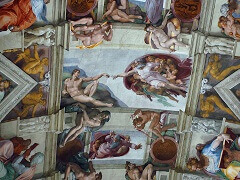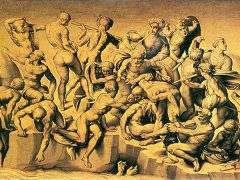Apollo, by Michelangelo

The sculpture has often been hypothesized that the figure was begun as a David and only later converted into an Apollo. If this were the case the small mound on the base must originally have been intended for Goliath's chopped-off head under the shepherd and hero's foot, like in the lost bronze David that Michelangelo had made for the marshal of Gie. But the iconography of the figure may have been misunderstood by the person who drew up the Medicean inventory in 1553 (the only source for the biblical identity), who was probably more familiar with the Bible than with Greco-Roman mythology, and especially with the image of the Old Testament character represented more than any other in Florence from the 14th century on, a symbol of the victory of the just protected by God.
The archer's movement as he draws an arrow from the quiver that hangs from his shoulder leads into an overall harmonious twisting, reminiscent of the solutions used in the Minerva Christ and in other figures (one arm hangs at his side while the other is raised and bent, his legs are apart, his feet at different levels, he tilts his head at the same turning turning his neck); but what is achieved here, by way of the figure's vague, absorbed expression, is calm and unconstrained sweetness.
















